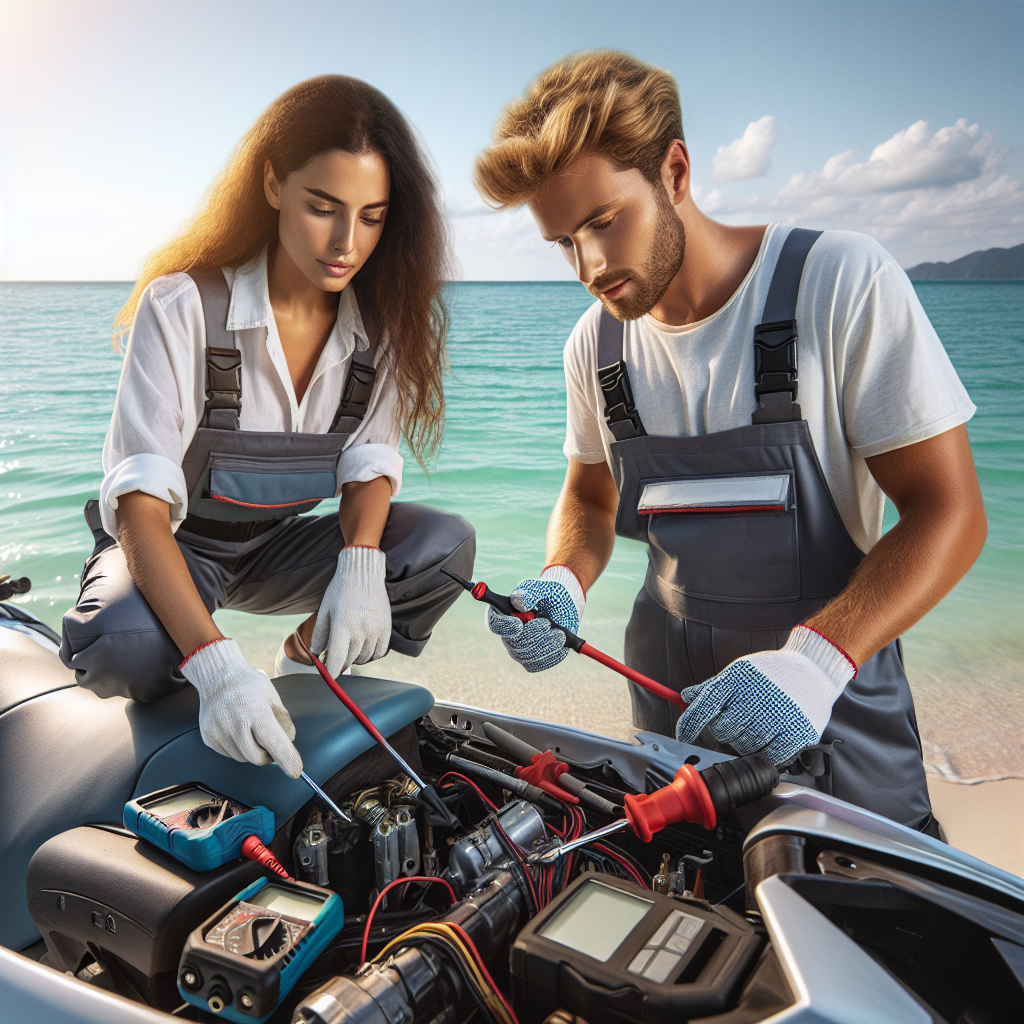How to Troubleshoot Common Problems with Jet Skis

Need help troubleshooting common problems with your jet ski? Look no further! In this article, we will provide you with expert advice on how to tackle those pesky issues that can arise when you’re out on the water. From engine problems to electrical malfunctions, we’ve got you covered. So, whether you’re a seasoned jet skier or a beginner, read on to discover valuable tips and tricks to keep your adventure running smoothly. And if you’re in need of a reliable jet ski rental, we highly recommend reaching out to the watersport experts at A2Z Powersport located in Gulf Shores, AL. With their top-notch service and extensive knowledge, they’ll ensure you have a fantastic experience on the water.
How to Troubleshoot Common Problems with Jet Skis
Jet skis are a popular choice for watersport enthusiasts, providing hours of thrilling fun out on the water. However, like any machine, they can encounter problems from time to time. It’s important to know how to troubleshoot these common issues so that you can get back to enjoying your jet ski as soon as possible. In this article, we will guide you through the process of troubleshooting common problems with jet skis, covering engine problems, electrical issues, fuel system troubles, battery malfunctions, starting difficulties, overheating concerns, steering problems, jet pump failures, throttle and acceleration issues, and watercraft performance. So let’s dive in!
Engine Problems
One of the most common problems jet ski owners may encounter is engine issues. If your engine isn’t running properly, it can prevent you from enjoying your ride. Here are some steps you can take to troubleshoot engine problems:
Inspecting the Spark Plugs
Start by checking the spark plugs. Over time, they can become fouled or worn out, leading to engine misfires or failures. Ensure that they are clean and in good condition. If necessary, replace them with new ones and retest your jet ski.
Checking the Air Filter
A dirty or clogged air filter can restrict airflow to the engine, resulting in poor performance. Locate the air filter housing and inspect the air filter. If it’s dirty or worn out, it’s time to clean or replace it.
Examining the Fuel Lines
Inspect the fuel lines for any signs of damage or leaks. Cracked or deteriorated fuel lines can cause fuel delivery issues, leading to engine problems. Replace any damaged fuel lines and ensure that they are properly connected.
Examining the Fuel Filter
The fuel filter prevents debris and contaminants from entering the engine. If it becomes clogged, it can restrict fuel flow and impact the engine’s performance. Check the fuel filter and clean or replace it if necessary.
By following these steps, you can troubleshoot and resolve many engine problems on your jet ski. However, if the issues persist, it’s recommended to consult a professional for further assistance.
Electrical Issues
Electrical problems can be frustrating and prevent your jet ski from starting or running smoothly. Here are some steps to troubleshoot common electrical issues:
Verifying Battery Connection
Check the battery’s connection to ensure it is secure. Loose or corroded battery terminals can disrupt the electrical flow and prevent the jet ski from starting. Clean the terminals and tighten the connections if needed.
Checking the Fuse
Inspect the fuse box for any blown fuses. A blown fuse can disrupt the electrical circuit and cause various electrical problems. If you find a blown fuse, replace it with a new one of the same rating.
Inspecting the Wiring
Carefully examine the wiring harness for any visible damage or loose connections. Damaged or disconnected wires can result in electrical issues. If you notice any problems, repair or replace the wiring as necessary.
Examining the Ignition Switch
The ignition switch is responsible for starting the jet ski’s engine. If it becomes faulty, it can prevent the engine from starting or cause intermittent electrical problems. If you suspect an issue with the ignition switch, have it inspected and replaced if needed.
Taking these steps will help you troubleshoot and resolve common electrical issues with your jet ski. However, if you’re unfamiliar with electrical systems, it’s advisable to seek professional assistance to ensure a safe and accurate diagnosis.
Fuel System Troubles
A properly functioning fuel system is essential for the optimal performance of your jet ski. If you’re experiencing fuel-related problems, here are some troubleshooting steps to follow:
Ensuring Fuel Tank Ventilation
Check the fuel tank’s ventilation system for any blockages. A blocked vent can cause a vacuum in the fuel tank, resulting in fuel flow issues. Clean or unclog the vent as necessary to maintain proper ventilation.
Checking the Fuel Level
Ensure that your jet ski has an adequate amount of fuel. Running out of fuel or having a low fuel level can cause the engine to stall or not start at all. Refuel if necessary and double-check the fuel gauge’s accuracy.
Inspecting the Carburetor
If your jet ski is equipped with a carburetor, inspect it for any obstructions or blockages. Over time, debris can accumulate, leading to poor fuel delivery. Clean the carburetor and its components thoroughly to ensure proper functioning.
Cleaning the Fuel Injectors
For jet skis equipped with fuel injection systems, consider cleaning the fuel injectors. Deposits or clogs in the injectors can disrupt fuel delivery, affecting your jet ski’s performance. Use a fuel injector cleaner specifically designed for marine engines to clean the injectors effectively.
Following these troubleshooting steps should help you identify and resolve common fuel system problems with your jet ski. However, for complex issues or if you’re not confident in your abilities, consult a professional for assistance.
Battery Malfunctions
Your jet ski’s battery powers the electrical components and provides the energy needed to start the engine. If you’re experiencing battery-related problems, here are some troubleshooting steps to follow:
Testing the Battery Voltage
Use a digital multimeter to test the battery’s voltage. A fully charged battery should have a voltage reading between 12.6 and 12.8 volts. If the voltage is significantly lower, the battery may need to be charged or replaced.
Verifying Battery Terminal Connections
Check the battery terminals for any corrosion or loose connections. Corroded terminals can inhibit electrical flow and prevent the battery from charging properly. Clean the terminals using a baking soda and water solution and ensure the connections are tight.
Cleaning Corroded Battery Contacts
Corroded battery contacts can negatively impact electrical conductivity. If you notice corrosion on the battery contacts, clean them using a wire brush or sandpaper. It’s important to wear protective gloves and eye protection during this process.
Replacing Old or Faulty Battery
If your battery is old or unable to hold a charge, it may need to be replaced. Consult your jet ski’s manual or a specialist to ensure you select the correct battery for your specific model. Follow the manufacturer’s instructions for proper installation.
By following these troubleshooting steps, you can identify and resolve battery-related malfunctions with your jet ski. However, if the problems persist, it’s recommended to seek professional assistance.
Starting Difficulties
Starting difficulties can be frustrating and prevent you from enjoying your ride. Here are some troubleshooting steps to help you address common starting issues with your jet ski:
Checking the Kill Switch
Ensure that the kill switch is in the “ON” position. If the switch is off, it will prevent the engine from starting. It’s a simple step that can save you time and frustration.
Inspecting the Starter Motor
The starter motor is responsible for cranking the engine and starting the jet ski. If the starter motor is faulty, it may not engage or spin properly. Inspect the starter motor for any signs of damage or wear. If necessary, have it tested and replaced.
Examining the Ignition Coil
The ignition coil produces the high voltage needed to ignite the fuel mixture in the engine. A faulty ignition coil can prevent the spark plugs from firing, resulting in starting issues. Test the ignition coil using a multimeter and replace it if needed.
Testing the Starter Solenoid
The starter solenoid is responsible for transferring electrical current from the battery to the starter motor. If the solenoid is faulty, it can prevent the engine from starting. Test the solenoid using a multimeter and replace it if necessary.
By following these steps, you can troubleshoot and resolve common starting difficulties with your jet ski. However, if the issues persist, it’s recommended to consult a professional for further assistance.
Overheating Concerns
Proper cooling is crucial to prevent your jet ski’s engine from overheating. If you notice any signs of overheating, it’s important to address the issue promptly. Here are some troubleshooting steps for dealing with overheating concerns:
Checking the Cooling System
Inspect the cooling system for any leaks, damage, or blockages. A damaged or clogged cooling system can prevent proper heat dissipation, leading to overheating. Repair or clean the cooling system components as needed.
Examining the Water Intake
Blocked or obstructed water intakes can restrict the flow of cooling water into the engine, causing it to overheat. Check the water intakes and remove any debris or obstructions that may be blocking the passage of water.
Verifying the Impeller Condition
The impeller plays a vital role in drawing water into the jet ski’s cooling system. Inspect the impeller for any signs of damage or wear. A damaged or worn impeller can hinder the cooling process and result in overheating. Replace the impeller if necessary.
Cleaning the Heat Exchanger
The heat exchanger is responsible for transferring heat from the engine to the surrounding water. Over time, the heat exchanger can accumulate mineral deposits or debris, reducing its efficiency. Clean the heat exchanger thoroughly to ensure optimal heat dissipation.
By following these troubleshooting steps, you can effectively address overheating concerns with your jet ski. If the problem persists, it’s advisable to seek professional assistance to prevent further damage.
Steering Problems
Maintaining proper control and maneuverability is essential for a safe and enjoyable jet ski experience. If you’re experiencing steering problems, here are some troubleshooting steps to follow:
Inspecting the Steering Cable
Check the steering cable for any signs of damage, wear, or corrosion. A damaged or worn steering cable can affect your ability to steer your jet ski properly. If needed, replace the steering cable and ensure it’s correctly installed.
Examining the Steering Nozzle
The steering nozzle directs the water flow, allowing you to control the direction of your jet ski. Inspect the steering nozzle for any blockages or damage. Clear any obstructions and replace the nozzle if necessary.
Checking the Handlebar Grips
Worn or damaged handlebar grips can make it difficult to maintain a firm grip and control of your jet ski. Verify that the handlebar grips are in good condition and replace them if needed for improved control.
Verifying the Steering Trim
The steering trim allows you to adjust the angle of the jet ski’s nozzle, affecting its handling and performance. If the steering trim system isn’t functioning correctly, it can cause steering issues. Inspect the steering trim components and ensure they are operating smoothly.
By following these troubleshooting steps, you can address common steering problems with your jet ski. If the issues persist, it’s recommended to consult a professional for further assistance.
Jet Pump Failures
The jet pump is responsible for propelling the jet ski through the water, and any issues with the pump can significantly affect performance. Here are some troubleshooting steps to help you address jet pump failures:
Inspecting the Impeller
The impeller is a vital component of the jet pump and can become damaged or worn over time. Inspect the impeller for any signs of damage or wear. If necessary, replace the impeller to restore optimal performance.
Checking the Wear Ring
The wear ring serves as a protective barrier between the impeller and the pump housing. Over time, the wear ring can become worn or damaged, resulting in decreased performance. Inspect the wear ring and replace it if needed.
Examining the Jet Nozzle
The jet nozzle controls the direction and intensity of the water flow ejected by the pump. Check the jet nozzle for any blockages or damage. Clear any obstructions and ensure the nozzle is in good condition.
Verifying the Pump Bearings
Faulty or worn pump bearings can cause excessive noise or vibrations and impact the overall performance of the jet pump. Inspect the pump bearings and replace them if necessary to maintain optimal functioning.
By following these steps, you can troubleshoot and resolve common jet pump failures. However, if the issues persist, it’s recommended to consult a professional for further assistance.
Throttle and Acceleration Issues
Proper throttle control and smooth acceleration are essential for a thrilling jet ski experience. If you’re experiencing throttle and acceleration issues, here are some troubleshooting steps to follow:
Inspecting the Throttle Cable
Check the throttle cable for any signs of damage, wear, or slack. A damaged or improperly adjusted throttle cable can affect throttle response. If needed, replace or adjust the throttle cable to ensure proper functioning.
Verifying the Throttle Body
The throttle body regulates the amount of airflow into the engine, affecting acceleration. Inspect the throttle body for any blockages or damage. Clean or replace the throttle body as necessary for improved acceleration.
Examining the Carburetor
If your jet ski is equipped with a carburetor, inspect it for any obstructions or blockages. Over time, debris can accumulate, leading to poor fuel delivery and throttle response. Clean the carburetor and its components thoroughly to ensure proper functioning.
Checking the Electronic Throttle Control (ETC) System
For jet skis with electronic throttle control systems, check for any error codes or malfunctions. Use a manufacturer-specific diagnostic tool to scan and troubleshoot the ETC system. Follow the diagnostic procedures outlined in your jet ski’s manual.
By following these troubleshooting steps, you can address common throttle and acceleration issues with your jet ski. However, if the problems persist, it’s recommended to consult a professional for further assistance.
Watercraft Performance
To ensure optimal performance and maximum enjoyment on your jet ski, it’s important to pay attention to its overall condition. Here are some areas to inspect and maintain for improved watercraft performance:
Examining the Hull and Bottom
Inspect the hull and the bottom of your jet ski for any visible damage, cracks, or wear. Damaged or worn hulls can impact the watercraft’s stability and performance. Repair any damage or consult a professional for larger repairs.
Checking the Intake Grate
The intake grate prevents debris from entering the jet pump, ensuring proper water flow. Check the intake grate for any obstructions or damage. Clear any debris and replace the grate if necessary.
Inspecting the Ride Plate
The ride plate provides stability and control while riding your jet ski. Inspect the ride plate for any signs of damage or wear. If needed, repair or replace the ride plate to enhance your watercraft’s performance.
Verifying the Sponsons
The sponsons are located on the sides of the jet ski’s hull and assist in stability and cornering. Inspect the sponsons for any damage or wear. Replace any damaged sponsons to maintain optimal performance.
By regularly inspecting and maintaining these areas, you can enhance the performance and lifespan of your jet ski. Additionally, it’s recommended to consult your jet ski’s manual for specific maintenance guidelines and intervals.
In conclusion, troubleshooting common problems with jet skis is essential to ensure a smooth and enjoyable experience on the water. By following the troubleshooting steps outlined in this article for engine problems, electrical issues, fuel system troubles, battery malfunctions, starting difficulties, overheating concerns, steering problems, jet pump failures, throttle and acceleration issues, and watercraft performance, you can identify and resolve many common problems. However, if you’re unsure or inexperienced, it’s always best to consult a professional for assistance to avoid further damage or safety hazards. Remember, it’s important to prioritize your safety and the longevity of your jet ski, so regular maintenance and inspections are key. Happy jet skiing!










